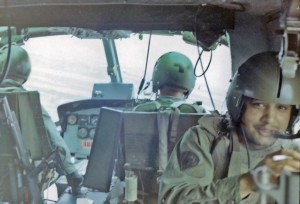
Body armor and flak jackets have been something sought after by armed forces around the globe to protect their troops from arms fire and shrapnel. Developed to prevent death and lessen injuries, body armor has been used in war combat since as early as world war one. Even from the first mediocre attempts at development, body armor has seen generations upon generations of revisions and weight reduction to provide the most efficient way of stopping rounds. This article however, will focus mainly on the creation of body armor for the Vietnam War for pilots and ground infantry.
Armor in the Air
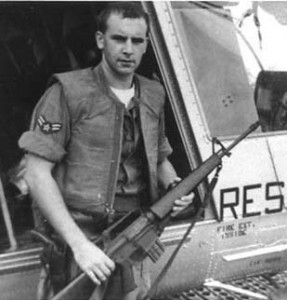
During the Vietnam war, one of America’s top strategies in combat was high air mobility. Army pilots often conducted low flying reconnaissance, rescue, and insertion missions which made the pilots vulernable to small arms fire. As hostilities increased, so did casualties to pilots and aircrew. The only protection these pilots had from enemy fire was the M1952A Fragmentation Vest from the late Korean War era. These flak jackets (the M1952A) which provided no real protection from small arms fire and were also standard issue to US Army infantry at the time. As information came in from the field, a new hard face composite was looked at to replace the previous DORON plates. This new lightweight (relatively speaking) ceramic composite was made into chest shields and issued in the TRECOM Aircraft Armor Kit from Natick Laboratories. Despite the protection offered from the new shields, both the Hard Face Composite and Doron shields where too uncomfortable for pilots to wear for any length of time, and as a result saw little usage in the field. Another side experiment by Natick used a curved torso shield made from 13 ceramic tiles bonded to a reinforced plastic shell. The shell then rested on the seat between the pilot’s legs. Defense Advanced Research Projects testing found that the new system reduced the weight to the pilot, but it interfered with the operation of the aircraft and was quickly scrapped. 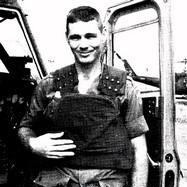
Natick Labs continued working on prototypes for new armor to be used in helicopters and soon came up the experimental T65-1 cloth back carrier that was mated to a prototype curved front torso using female snap fasteners. Padded shoulder sections helped distribute the armor’s weight and a cloth wrap around straps with a Velcro fastener held the vest in place. Natick Labs members and AMC armor team members visited Vietnam in 1965 to obtain reception of the concept armor and found that combatants responded well to its use. The only drawback from the field was that aircrews stated the plates were too large and not ergonomic making them uncomfortable. Pilots and aircrew both overwhelming stated they would sacrifice protection and risk increased exposure to small arms fire for comfort. As a result, the HFC vest was reduced in size by 3 inches and made more contoured in the shoulder and arm area. Coupled with the T65-1 cloth back vest, this Aircrew Body Armor set became the infamous “chicken plate” that would serve Army aviators for the next 30 years. 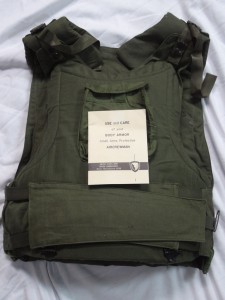
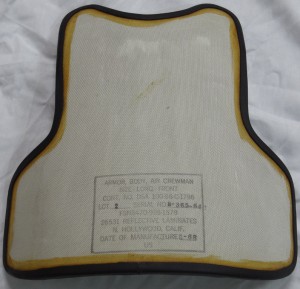
Infantry Armor in the Field
The first use of efficient body armor by US infantrymen was the USMC-M1951 vest. The vest, like all of its contemporaries, offered protection against shrapnel and fragmentation, but did not offer any protection against small arms fire. The Marines and the Army both developed body armor of roughly equal efficiency, but their development paths would follow different routes. The Army would introduce the M52 and soon M52A which would feature “soft” armor made of ballistic fabric. The Marines would use hard Doron plates that would give their armor a rigid quality.
The Marines
The USMC M-52 Fragmentation Vest had three primary variants with minor modifications during the Korean War. Design improvements were quickly incorporated and by the third model, you can clearly see the basis for the M-55 that would servethroughout the Vietnam War and well into the 1980’s.
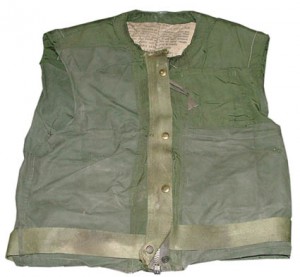
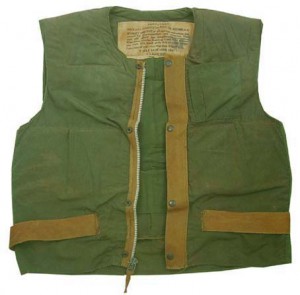
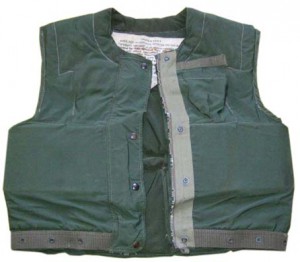
Based on the final M-52 design as shown above, the M-55 series was born. The basis of the M-55 was a cotton shell with zipper front and 23 Doron Plates in the main body with ballistic fabric in the shoulder areas. The vest also included a rope ridge sewn into the shoulder area to help prevent a rifle butt or sling from sliding off of the face of the vest. The first version had a single, small pocket on the left chest area. In 1967 the vest was modified and a “second” version was introduced with large pockets located on the lower front area on each side of the zipper. The pockets were nylon and offer a contract to the cotton fabric of the shell. The final version of the vest included a body made of nylon to match the pockets. This change was aimed at addressing wear issues with the cotton body of the vest. Of note, there are versions with a single rope ridge as well as a double rope ridge (as shown) on each shoulder.
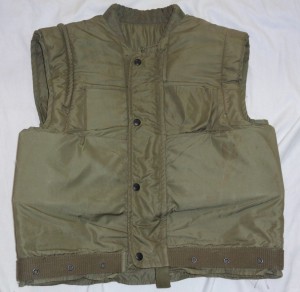
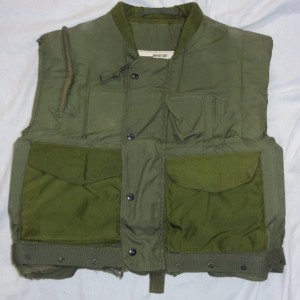
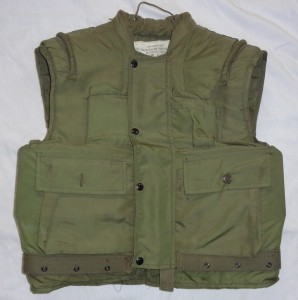
In the later part of the 1960’s, both the Army and Marines recognized the limitations of fragmentation vests and the benefits of being able to field armor that would actually stop a .30 cal AP round. They both looked to the success of the Aircrew Body Armor and used the ceramic plates as a basis for infantry armor. The Marines developed a carrier made of rough ballistic nylon in ERDL camo print. The carrier had an integrated “haversack” on the back and pockets to hold the ceramic plates in both the front and back. This system, like the Army Variable Body Armor, was deemed insufficient for several reasons, primarily weight. As such, it was made in extremely limited numbers and never tested in Vietnam. 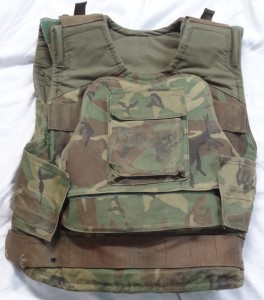
The Army
The standard Army infantry vest at the beginning of the war was the M1952A from the late Korean War era. It would be the most commonly seen fragmentation vest in Army use through 1966. The vest is easily distinguished by its brown color, lack of a collar, and epaulettes on the shoulder. It features a zipper front with nylon over flap. This style of vest would remain popular with vehicles crews as the lack of a collar make it more comfortable to wear with a helmet.
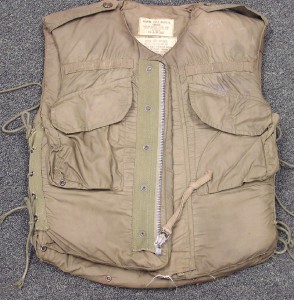
When looking at ways to improve the vest, the first thought, aside from more effective materials was to increase the area of protection. The new vest was very similar to the M52 in basic design: zipper front, two pockets, lace sides, etc. but it featured a collar. Hence they were labeled as Armor, Body Fragmentation Protective, With, 3/4 Collar. The first six months of production saw a version with epaulettes on the shoulder. This is the first vest with the “823” specification on the label. 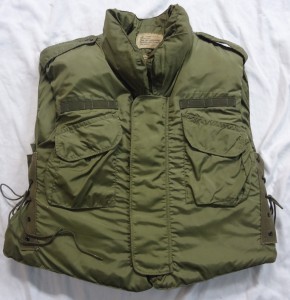
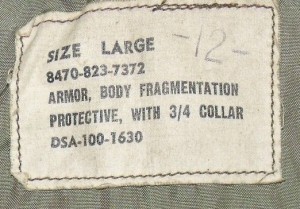
The next variation in the Army Flak Jacket came when they decided to simplify production of the vests and dropped the epaulettes on the shoulder. The resulting vest is the iconic Army flak vest of the Vietnam War. At this point, no other changes were made and the spec tag still retained the 823 designation. The vest would continue production in this manner through 1968.
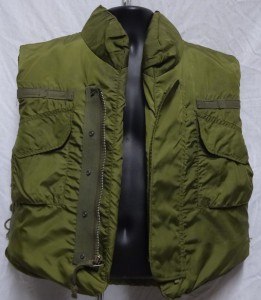
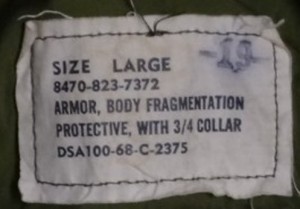
There were some minor issues with the design, chief among them a tendency for the armor to bunch up inside the vest. As a result, in late 1968, an improvement was designed into the internal ballistic filler in an effort to prevent bunching. The new model was cosmetically identical, but featured a different contract specification number to reflect the change in material. These changes would take place in the production year of 1969 ending the 823 contract series production and replacing them with the 122 series as the code for the new anti-bunching inserts. At this point, it was still referred to as Armor, Body Fragmentation Protective, with 3/4 Collar Fragmentation and featured the zipper front. 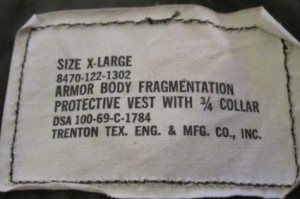
The final changes to the 3/4 Collar Flak were ordered in late 1969 for production to start in 1970. The vest would retain the 122 designation and the new anti-bunching inserts, but they would change the zipper front closure to a velcro closure. The thought process was that zippers could be damaged in combat by shrapnel or fragments making the vest difficult to remove from a wounded solder. This was the first cosmetic change since the epaullettes were removed at the end of 1966. These vests began production in 1970 and had a nomenclature change as well. At this point, the vest was renamed Armor Body Fragmentation Protective Vest with 3/4 Collar, M-69
.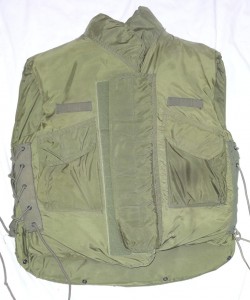
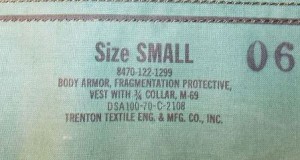
While production and design improvements were being made on the 3/4 Collar vests, there was still a push to apply the technology from the ceramic plates of the Aircrew Body Armor (chicken plate) for infantry use. The concept was a bullet proof vest for infantry use was intriguing and the need for it became more apparent as casualties grew in Vietnam. The result of Natick’s efforts was Variable Body Armor. The armor set consisted of a nylon felted vest with a front and rear ceramic plates. It was named Variable Armor as the carrier could be worn alone for protection from fragments, the plates could be worn alone utilizing Velcro and buckled straps, or the plates could be worn in conjunction with the vest carrier to provide maximum protection. The system did provide protection from .30 cal AP rounds, but due to its weight at 20 pounds and the bulk of the system it was never popular in the tropical heat and humidity of Vietnam. Variable armor could be worn with the carrier as shown or the plates could be worn together without the carrier. Due to the weight, 20 pounds, the system was very unpopular with Infantry and was never widely used.
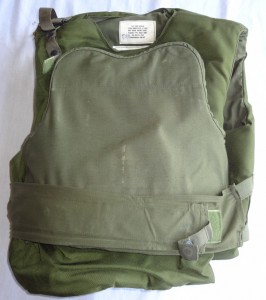
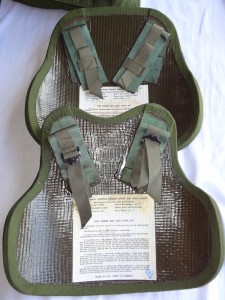
Legacy
Despite their shortcomings, the USMC experimental body armor with hard plates and the US Army’s Variable Body Armor were important steps in the development of bullet proof body armor for ground troops. The concepts were sound, but the technology was just not there to reduce weight and provide a viable vest. After the war, both the USMC M-55 vest and the Army M-69 vest would see another 15 years of service but development of the next generation of armor would rely heavily on the experimental models from the Vietnam War. The final result was the development of the Personnel Armor System for Ground Troops (PASGT) introduced in the mid 1980’s. With the introduction of the PASGT system, the M-55 and M69 of Vietnam fame were finally retired.








